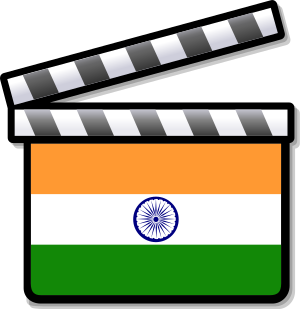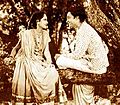Bollywood facts for kids
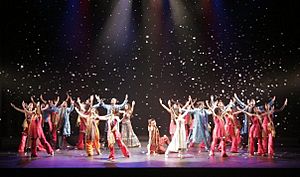
Bollywood is the name for the film industry in Mumbai, India. It makes movies mostly in the Hindi language. The word "Bollywood" is a mix of "Bombay" (Mumbai's old name) and "Hollywood". This industry is a big part of the larger Indian cinema, which also includes films from South India and other languages.
In 2017, Indian cinema made almost 2,000 feature films. Out of these, 364 were in Hindi. Bollywood is one of the biggest places in the world for making movies.
Contents
- What is the name "Bollywood"?
- History of Bollywood
- Types of Bollywood Movies (Genres)
- What Bollywood Movies are Like
- Languages in Bollywood Films
- Bollywood Actors
- Bollywood Movies' Length and Plots
- Music in Bollywood
- How Bollywood is Changing
- Bollywood Awards
- Bollywood Around the World
- See also
- Images for kids
- See also
What is the name "Bollywood"?
The name "Bollywood" comes from "Bombay" (Mumbai's old name) and "Hollywood." Hollywood is a famous place in California, United States, known for its film industry.
The term "Tollywood" was used in 1932 for the film industry in Tollygunge, West Bengal. It was mentioned in an article by an American engineer.
"Bollywood" was probably created in film magazines in Mumbai during the 1960s or 1970s. We don't know if it came from "Hollywood" through "Tollywood," or if it was directly inspired by "Hollywood." Some people don't like the name because they think it makes the industry seem less important than Hollywood.
Since then, "Bollywood" has inspired many other similar names for film industries around the world.
History of Bollywood
Early days (1890s–1930s)
In 1897, a show in Kolkata featured a film. An Indian photographer named Hiralal Sen made a film of scenes from that show. Later, in 1899, The Wrestlers showed a wrestling match in Mumbai.
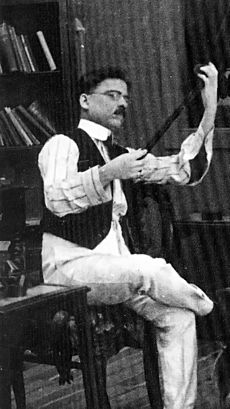
Dadasaheb Phalke made India's first full-length silent film, Raja Harishchandra, in 1913. By the 1930s, the industry was making over 200 films each year. The first Indian film with sound, Alam Ara (1931), was a big success. People loved "talkies" (films with sound) and musicals. So, Hindi cinema and other regional film industries quickly started making sound films.
Growth and challenges (1930s–1940s)
The 1930s and 1940s were tough times for India. There was a big economic crisis, World War II, and the movement for India's independence. Many early Mumbai films were made to help people escape from their worries. But some filmmakers also showed real social problems or used the fight for independence in their movies.
The first Hindi color film, Kisan Kanya, was made in 1937. But color films didn't become popular until the late 1950s. During this time, grand romantic musicals and emotional dramas were very common.
In the 1940s, Mumbai cinema became even more popular across India. In 1943, the movie Kismet became India's first "blockbuster." It earned a lot of money and was the longest-running hit film for many years. This film talked about important issues from the independence movement. Many film stars and directors used their movies to support the national movement against colonial rule. They also used these popular movements to become more famous.
Before India was divided in 1947, the Mumbai film industry was connected to the Lahore film industry (now in Pakistan). Both made films in Hindustani, which was spoken across northern and central India. Many actors and musicians moved from Lahore and Kolkata to Mumbai in the 1940s. This made Mumbai the main center for making Hindustani-language films.
The division of India in 1947 led to many film artists moving to Mumbai. This made Mumbai's film industry even stronger as the top place for making films in India.
Golden Age (late 1940s–1960s)
The time from the late 1940s to the early 1960s, after India became independent, is called the Golden Age of Hindi cinema. Some of the best Hindi films ever were made then. Movies like Pyaasa (1957) and Awaara (1951) explored social topics, especially about working-class life in cities.
Mehboob Khan's Mother India (1957) was the first Indian film nominated for an Academy Award for Best Foreign Language Film. It almost won! Mother India set the standard for many Hindi films for decades. It also inspired a type of film about bandits. Big historical films like Mughal-e-Azam (1960) were also made during this time.
The most popular male actors of the 1950s and 1960s were Dilip Kumar, Raj Kapoor, and Dev Anand. Each had a special acting style. Dilip Kumar was known for his deep, realistic acting, which inspired many future actors. Famous actresses like Nargis, Madhubala, and Waheeda Rehman also had a big impact on Hindi cinema.
Besides commercial films, the 1950s also saw the start of "parallel cinema." These were more realistic films. Early examples include Dharti Ke Lal (1946) and Neecha Nagar (1946). Neecha Nagar even won a top award at the 1946 Cannes Film Festival. This led to a new style of Indian realistic films.
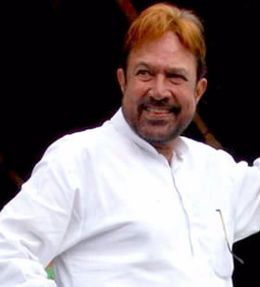
Hindi films often competed for top awards at the Cannes Film Festival in the 1950s and early 1960s. Some even won big prizes. Later, in the 1980s, director Guru Dutt received international fame for his films. His movie Pyaasa is considered one of the greatest films of all time.
In the late 1960s and early 1970s, romantic musical films with charming heroes were very popular.
Classic Hindi cinema (1970s–1980s)
By 1970, Hindi cinema was becoming a bit boring, with too many similar romantic musicals. Then, the screenwriting team of Salim–Javed (Salim Khan and Javed Akhtar) changed everything. They started making tough, action-packed crime films about the Mumbai underworld, like Zanjeer (1973) and Deewaar (1975).
These films showed the social problems of 1970s India, like poverty, corruption, and crime in cities. They featured an "angry young man" character, played perfectly by Amitabh Bachchan. This character showed the anger and frustration of city people.
The name "Bollywood" was created in the 1970s. This was when the style of commercial Hindi films became clear. A key part of this was the "masala film." This type of film mixes many different genres, like action, comedy, romance, drama, and musicals.
Filmmaker Nasir Hussain and the Salim-Javed team started the masala film trend. Yaadon Ki Baarat (1973) is often seen as the first true "Bollywood" film. Salim-Javed wrote many more successful masala films. These films made Amitabh Bachchan the biggest star of that time. Amar Akbar Anthony (1977) was another famous masala film.
Some Hindi filmmakers, like Shyam Benegal, continued to make realistic "parallel cinema" films in the 1970s. But commercial films like Sholay (1975) became very popular, making Amitabh Bachchan an even bigger star.
By 1983, the Mumbai film industry was earning a lot of money. By 1986, India was making more films than any other country in the world. The film Salaam Bombay! (1988) won an award at the 1988 Cannes Film Festival and was nominated for an Academy Award.
New Hindi cinema (1990s–2000s)
In the late 1980s, Bollywood films faced a decline because of too much violence and less good music. Also, video piracy was a problem. A turning point came with films like Qayamat Se Qayamat Tak (1988). These movies had a fresh, youthful feel, family entertainment, and great songs. They brought audiences back to cinemas. This film style set the trend for Bollywood musical romance films in the 1990s.
Since the 1990s, this era is called "New Bollywood." It started when India's economy became more open. Family-focused romantic musicals became popular again. Blockbusters like Hum Aapke Hain Kaun (1994) and Dilwale Dulhania Le Jayenge (1995) came out. A new generation of popular actors, known as the Three Khans (Aamir Khan, Shah Rukh Khan, and Salman Khan), became very famous. They have been top stars for decades. Shah Rukh Khan was the most successful in the 1990s and 2000s, and Aamir Khan has been very successful since the mid-2000s. Action and comedy films with actors like Akshay Kumar were also popular.
The 1990s also saw new actors in independent films. Some of these were successful. A very important film was Satya (1998). Its success led to a new type of film called "Mumbai noir," which showed the city's social problems. This brought back "parallel cinema" by the end of the decade.
The 2000s saw Bollywood become more known around the world. This was partly because more Indians lived overseas. As India's economy grew, the film industry improved its production quality, cinematography, and special effects. Big production houses like Yash Raj Films and Dharma Productions made modern films. Popular movies of this decade included Lagaan (2001), Kabhi Khushi Kabhie Gham... (2001), and Rang De Basanti (2006).
In the 2010s, famous stars continued to make big-budget masala films. These films were often very successful at the box office, even if critics didn't always love them.
Types of Bollywood Movies (Genres)
The most popular type of commercial film in Hindi cinema since the 1970s is the "masala film."
In Hindi, Masala means "spice mixture." These movies usually have a lot of emotion, songs, revenge, and stories about differences between rich and poor.
A masala film mixes different types of stories. It can have action, comedy, romance, drama, and emotional scenes, along with many musical numbers. Masala films are almost always musical films.
There is also a type of art film called "parallel cinema." These films show more realistic stories and usually do not have musical numbers. Lately, the difference between commercial masala films and parallel cinema has become less clear.
What Bollywood Movies are Like
Generally, Bollywood movies are like musicals. The audience expects to hear music. There are usually song-and-dance numbers as part of the story. Often, how well a movie does depends on how good these musical numbers are. The movie music is often released before the movie itself, which helps build excitement.
Languages in Bollywood Films
Bollywood movies are usually in Hindi. A more accurate way to describe the language is Hindustani, which is a common part of both Hindi and Urdu. Sometimes, poetic Urdu words are used.
More and more, English words are used in dialogues and songs. Some movies now have parts of the dialogue in English. There are also a growing number of movies made entirely in English. Some films are made in more than one language, either with subtitles or different soundtracks.
Bollywood Actors
A good entertainer in Bollywood is called paisa vasool, meaning "money's worth." Bollywood movies often mix songs, dances, love triangles, comedy, and thrills. These are the "masala" movies, named after the Hindi word for a spice mixture.
Bollywood Movies' Length and Plots
Bollywood movies are often longer than Hollywood films. A typical Bollywood movie can be about 3 hours long. They are made for a wide audience. Other Indian movies might try to be more artistic, but they often don't earn as much money as the popular "masala" films.
Bollywood plots are usually very emotional. They often use common ideas like lovers who can't be together, angry parents, love triangles, strong family bonds, sacrifice, corrupt politicians, kidnappers, bad guys, long-lost relatives, and surprising coincidences.
Music in Bollywood
Bollywood songs are called Hindi film songs or "filmi songs." Most movies have songs in them. Bollywood songs and dances are a key part of Hindi cinema. They make these movies popular and add to their cultural value. The songs are sung by playback singers, and the actors and actresses lip sync to them on screen.
How Bollywood is Changing
Bollywood is changing its ways. Many Indians live in English-speaking countries, and there's more Western influence in India. This has made Bollywood movies a bit more like Hollywood films. For example, kisses are now allowed in movies. Plots now often show young city people dating and dancing in discos, instead of only showing arranged marriages.
In 2001, five percent of Indian movies were shown in Britain.
Bollywood Awards
The Filmfare Awards are very important awards for Hindi films in India. They started in 1954. The way winners are chosen is similar to the Academy of Motion Picture Arts and Sciences' system (like the Oscars).
The National Film Awards also started in 1954. These awards are given out at a yearly ceremony led by the President of India. Unlike the Filmfare Awards, which are chosen by the public and experts, the National Film Awards are decided by a government panel.
Other award shows for Hindi films include the Screen Awards (started in 1995) and the Stardust Awards (started in 2003). The International Indian Film Academy Awards (started in 2000) and the Zee Cine Awards (started in 1998) are held in different countries each year.
Bollywood Around the World
Bollywood films are very popular not just with Indians living abroad, but also with non-Indians in places like Nigeria, Egypt, and Russia. In recent years, Bollywood has become more popular with Western audiences and filmmakers. Now, Western actors sometimes look for roles in Bollywood films.
See also
Images for kids
-
Nargis, Raj Kapoor and Dilip Kumar in Andaz (1949). Kapoor and Kumar are among the greatest and most influential movie stars in Indian cinema, and Nargis is one of its greatest actresses.
-
Amitabh Bachchan in 2014.
-
Salman Khan, one of the Three Khans, with Bollywood actresses (from left) Kareena Kapoor, Rani Mukerji, Preity Zinta, Katrina Kaif, Karisma Kapoor and Priyanka Chopra in Mumbai (2010).
-
Akshay Kumar in 2013.
-
Ajay Devgn and Rohit Shetty on the sets of Jhalak Dikhhlaa Jaa 5.
-
Michelle Obama joining students for a Bollywood dance clinic with Nakul Dev Mahajan in the White House State Dining Room, 2013.
See also
 In Spanish: Bollywood para niños
In Spanish: Bollywood para niños


